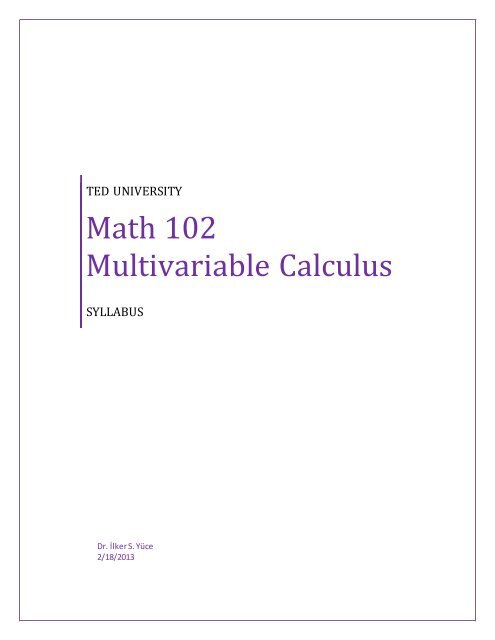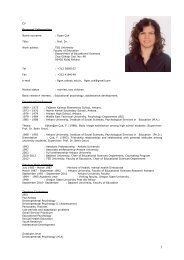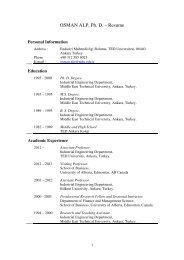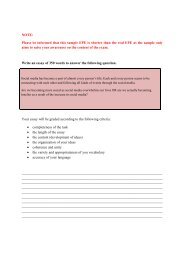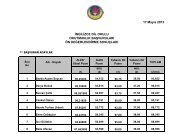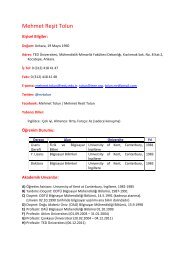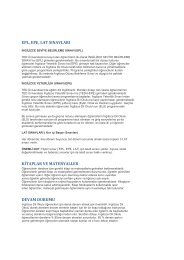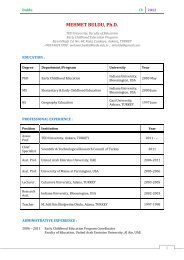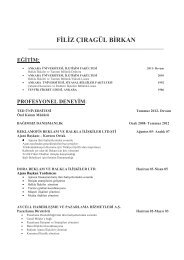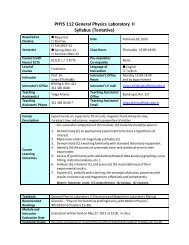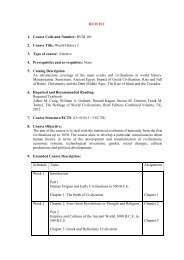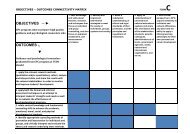Math 102 Multivariable Calculus
Math 102 Multivariable Calculus
Math 102 Multivariable Calculus
Create successful ePaper yourself
Turn your PDF publications into a flip-book with our unique Google optimized e-Paper software.
TED UNIVERSITY<br />
<strong>Math</strong> <strong>102</strong><br />
<strong>Multivariable</strong> <strong>Calculus</strong><br />
SYLLABUS<br />
Dr. İlker S. Yüce<br />
2/18/2013
Required or<br />
Elective<br />
Semester<br />
Course Credit<br />
Hours/ ECTS<br />
credits<br />
Level of Course<br />
Instructor<br />
Instructor’s Office<br />
& Phone Numbers<br />
Teaching<br />
Assistant(s)<br />
Teaching Assistants’<br />
Office Phone<br />
Required<br />
Elective<br />
Fall 12-13<br />
Spring 12-13<br />
Summer 12-13<br />
(3,2,0) 4 / 7<br />
Freshman<br />
Dr. İlker S. Yüce<br />
Building A, O421,<br />
312 585 01 15<br />
Date February, 18th 2013<br />
Class Hours<br />
Pre-requisite/<br />
Co-requisite<br />
Language of<br />
Instruction<br />
Instructor’s Office<br />
Hours<br />
Instructor’s E-mail<br />
Address<br />
Teaching Assistants’<br />
Office Number(s)<br />
Teaching Assistants’<br />
Email Addresses<br />
M. 9am-10am, Rm 316<br />
W. 10am, Rm. 316<br />
F. 10am-11am, Rm 316<br />
<strong>Math</strong> 101<br />
English<br />
Turkish<br />
Monday 11am,<br />
Wednesday 11am<br />
Friday 9am, or by<br />
appointment.<br />
ilkers.yuce@tedu.edu.tr<br />
Course<br />
Description<br />
Course<br />
Learning<br />
Outcomes<br />
Vectors in R 2 and R 3 , Dot and Cross Products, Lines and Planes in R 3 . Vector-Valued<br />
Functions, and Their Limits, Continuity and Derivatives, Curvature. Functions of<br />
Several Variables and Their Limit and Continuity, Partial derivatives, Directional<br />
Derivatives, Maximum-Minimum Problems, Lagrange multipliers. Double Integrals,<br />
Triple Integrals, Vector Fields, Line Integrals, Green’s Theorem, Surface Integrals,<br />
Stokes’s and Divergence Theorem.<br />
On successful completion of this module, the students should be able to<br />
1. Recall basic principles of mathematical writing together with conventions,<br />
mathematical notation and fundamental definitions related to<br />
multivariable scalar and vector valued functions,<br />
2. Write equations of lines and planes in R 3 by the help of dot and cross of<br />
vector.<br />
3. Extend the concepts of limit and continuity to multi-variable scalar and<br />
vector valued functions.<br />
4. Calculate limits, partial derivatives, directional derivatives, and multiintegrals<br />
of multi-variable scalar functions in various coordinate systems<br />
algebraically, graphically, and numerically<br />
5. Compute limits, derivatives and curvature of vector valued functions<br />
algebraically, graphically and numerically.<br />
6. Solve problems of Maximum-Minimum Values and Lagrange Multipliers<br />
for multi-variable scalar functions.<br />
7. Calculate line integrals, divergence, gradient and curl of vector fields.<br />
8. Use main theorems of vector calculus such as Green’s Theorem, Stokes’s<br />
Theorem and Divergence Theorem.<br />
2
Bloom’s Taxonomy Levels: K. Knowledge, C. Comprehension, a. Application.<br />
1 (K), 2(K),3(C),4(a),5(a),6(a),7(a),8(a)<br />
Teaching Methods<br />
& Learning<br />
Activities<br />
Telling/Explaining<br />
Discussions/Debates<br />
Questioning<br />
Reading<br />
Peer Teaching<br />
Scaffolding/Coaching<br />
Demonstrating<br />
Problem Solving<br />
Inquiry<br />
Collaborating<br />
Think-Pair-Share<br />
Predict-Observe-Explain<br />
Microteaching<br />
Case Study/Scenario Analysis<br />
Simulations & Games<br />
Video Presentations<br />
Oral Presentations/Reports<br />
Concept Mapping<br />
Brainstorming<br />
Drama/Role Playing<br />
Seminars<br />
Field Trips<br />
Guest Speakers<br />
Hands-on Activities<br />
Service Learning<br />
Web Searching<br />
Experiments<br />
Other(s): ....Written<br />
Homework......<br />
Student Workload<br />
(Total 175 Hrs)<br />
Lectures .....................................70.. hrs<br />
Course Readings ....................25.. hrs<br />
Workshop ......................................... hrs<br />
Online Discussion .......................... hrs<br />
Debate ................................................. hrs<br />
Work Placement ............................. hrs<br />
Field Trips/Visits ........................... hrs<br />
Observation ...................................... hrs<br />
Lab Applications ............................ hrs<br />
Hands-on Work ............................. hrs<br />
Exams/Quizzes .......................20.. hrs<br />
Resource Review ........................... hrs<br />
Research Review ........................... hrs<br />
Report on a Topic ......................... hrs<br />
Case Study Analysis ..................... hrs<br />
Oral Presentation ......................... hrs<br />
Poster Presentation ...................... hrs<br />
Demonstration ................................ hrs<br />
Web Designs .................................... hrs<br />
Mock Designs ................................... hrs<br />
Team Meetings................................ hrs<br />
Other: Written Homework..60. hrs<br />
Assessment<br />
Methods (Formal<br />
& Informal)<br />
Test/Exam<br />
Quiz<br />
Oral Questioning<br />
Performance Project<br />
WrittenOral<br />
Observation<br />
Self-evaluation<br />
Peer Evaluation<br />
Portfolio<br />
Presentation (Oral, Poster)<br />
Other(s): Written Homework<br />
Textbook<br />
<strong>Calculus</strong>, A Complete Course, 7 th Edition, by Adams and Essex.<br />
Recomended Readings<br />
<br />
<br />
<br />
James Stewart, <strong>Calculus</strong>, 7 th Edition<br />
Thomas’ <strong>Calculus</strong>, 12 th Edition<br />
<strong>Calculus</strong>, Single and <strong>Multivariable</strong>, 2 nd Edition, Blank and Krantz<br />
3
Module and Instructor<br />
Evaluation Date<br />
Design Content<br />
Computer Usage<br />
Evaluation will be held on Monday May 20 th , 2013 at 10:40 am in the<br />
class.<br />
Problem Sets from WeBWorK will be assigned for extra credit. Please see<br />
the web page http://math.tedu.edu.tr/webwork2<br />
COURSE ASSESSMENTS & LEARNING OUTCOMES MATRIX<br />
Assessment Methods<br />
Course Learning Outcomes<br />
Weekly Quizzes #1, #2, #3, #4, #5, #6, #7, #8<br />
Weekly Homework #1, #2, #3, #4, #5, #6, #7, #8<br />
Exam 1 #1, #2, #3, #4<br />
Exam 2 #1, #2, #3, #4, #5,#6<br />
Exam 3 #1, #2, #3, #4, #5, #6, #7, #8<br />
Final Exam #1, #2, #3, #4, #5, #6, #7, #8<br />
GRADING SCALE<br />
Grade Grade Points Percentage Scores<br />
AA 4.00 90-100<br />
BA 3.50 85-89<br />
BB 3.00 80-84<br />
CB 2.50 75-79<br />
CC 2.00 70-74<br />
DC 1.50 65-69<br />
DD 1.00 60-64<br />
F 0.00 0-59<br />
FX 0.00 -<br />
4<br />
COURSE ASSIGNMENTS<br />
A. Quiz [%5]<br />
There will be 12 quizzes given weekly. They will be held on Friday of each week. Some of quiz<br />
grades MAY be dropped.<br />
B. Homework [%10]<br />
There will be 12 homework given weekly. They will be collected on Monday of each week. Some of<br />
homework grades MAY be dropped.<br />
C. Exams[%15+%15+%20]<br />
There will be 3 one hour in class exams. Exam 1 is on 10/23 covering Sections P1-2.3 Exam2 is on<br />
11/27 covering Sections 2.3-4.6. Exam 3 is on 12/25 covering Section 4.8-6.5.
D. Final[%35]<br />
There will a cumulative final. Date of the final will be announced at the end of the semester.<br />
E. Extra Credit Work[%10]<br />
There will be extra credit work assigned via WeBWorK for interested students. Visit the web page<br />
http://math.tedu.edu.tr/webwork2 .<br />
TENTATIVE COURSE OUTLINE<br />
W Day Topics Objectives<br />
1<br />
2<br />
3<br />
4<br />
5<br />
6<br />
5<br />
2/18<br />
2/20<br />
2/22<br />
2/25<br />
2/27<br />
3/1<br />
3/4<br />
3/6<br />
3/8<br />
3/11<br />
3/13<br />
3/15<br />
3/18<br />
3/20<br />
3/22<br />
3/25<br />
3/27<br />
3/29<br />
<br />
<br />
<br />
Improper Integrals<br />
Volumes by slicing, solids<br />
of revolution<br />
Arc Length and Surface<br />
area<br />
Sequences and<br />
convergence<br />
Infinite series<br />
Convergence tests for<br />
positive series<br />
Absolute and conditional<br />
convergence<br />
Power series<br />
Taylor and Maclaurin<br />
series<br />
Applications of Taylor and<br />
Maclaurin Series<br />
Analytic Geometry in<br />
Three Dimensions<br />
Vectors<br />
The Cross Product in 3-<br />
Space<br />
ONE HOUR EXAM 1<br />
Planes and Lines<br />
Quadratic Surfaces<br />
Cylindrical and Spherical<br />
Coordinates<br />
Functions of Several<br />
Variables<br />
Limits and continuity<br />
Partial Derivatives
7<br />
8<br />
9<br />
10<br />
11<br />
12<br />
13<br />
14<br />
4/1<br />
4/3<br />
4/5<br />
4/8<br />
4/10<br />
4/12<br />
4/15<br />
4/17<br />
4/19<br />
4/22<br />
4/24<br />
4/26<br />
4/29<br />
5/3<br />
5/6<br />
5/8<br />
5/10<br />
5/13<br />
5/15<br />
5/17<br />
5/20<br />
5/22<br />
5/24<br />
<br />
<br />
Higher-Order Derivatives<br />
The Chain Rule<br />
Linear Approximations,<br />
Differentiability, and<br />
Differentials<br />
Gradients and directional<br />
derivatives<br />
Implicit Functions<br />
Extreme Values<br />
Extreme Values of<br />
functions defined on<br />
restricted domains<br />
Lagrange multipliers<br />
ONE HOUR EXAM 2<br />
Double Integrals<br />
Iteration of double<br />
integrals in Cartesian<br />
coordinates<br />
Polar coordinates and<br />
polar curves<br />
Double integrals in polar<br />
coordinates<br />
Triple Integrals<br />
Change of Variables in<br />
Triple Integrals<br />
<br />
<br />
<br />
<br />
Vector and Scalar Fields<br />
Conservative fields<br />
Line integrals<br />
Line Integrals of vector<br />
fields<br />
Gradient, Divergence, and<br />
Curl<br />
Green’s Theorem<br />
ONE HOUR EXAM 3<br />
Review<br />
Module & Instructor<br />
Evaluation<br />
FINAL EXAMS WEEKS<br />
May 27-June 7, 2013<br />
6
COURSE POLICIES AND SOME REMARKS<br />
I. Attendance<br />
You are expected to attend all classes. Classes start on the hour. Please be respectful of your<br />
classmates by being on time. Cell phones should be turned off and kept out of sight. Please do not<br />
use your computers during class time.<br />
II. Calculator Policy<br />
You may use a graphing calculator or software that does symbolic calculations. The recommended<br />
models are TI-83, or TI-89 from Texas Instruments or a suitable alternative. But you will NOT be<br />
allowed to use them during exams. You should have an owner’s manual for your calculator. It will<br />
be your responsibility to be familiar with the workings of the calculator.<br />
III. Course Web Pages<br />
Please check the link http://math.tedu.edu.tr regularly to have access to sources like sample<br />
exams and quizzes, solutions of homework assignments, exams, quizzes, and practice exercises,<br />
copies of handouts, summaries of each lectures, etc.<br />
IV. Tutoring<br />
In addition to office hours, there will be tutoring hours offered by appointment to get help. If you<br />
feel that you need to sign up for tutoring, please visit Dr. Mana Ece Tuna (Rm. 147, Phone: 585 00<br />
45, email: mana.tuna@tedu.edu.tr) for necessary arrangements.<br />
V. Assignment Rules<br />
Written homework is a very important part of this course. It is evident that your understanding of<br />
the module material will improve dramatically if you do the homework. Because of the size of this<br />
class there will be strict written homework rules:<br />
1. Use standard size 21cm x 29.7 cm paper, NOT torn from a spiral notebook.<br />
2. Multiple pages must be stapled. Please do not use paper clips. No loose sheets or<br />
folded corners.<br />
3. Written homework must be readable. If the grader can’t read it, you don’t get the<br />
credit.<br />
4. LATE HOMEWORK WILL NOT BE ACCEPTED.<br />
VI. Plagiarism<br />
Collaboration on non-collected homework and in studying is strongly encouraged; however, the<br />
work you hand in must be solely your own. Sharing written work before it is turned in to be graded<br />
is academic dishonesty. For more information on TEDU policy on intellectual integrity see the link<br />
http://www.tedu.edu.tr/Assets/Documents/News/Public/TEDU_Ogrenci_El_Kitabi_2012.pdf<br />
.<br />
VII. Disability Support<br />
If you have a disabling condition which may interfere with your ability to successfully complete this<br />
module, please contact Dr. Aslı Bugay (email: asli.bugay@tedu.edu.tr ) or Dr. Tolga İnan (email:<br />
tolga.inan@tedu.edu.tr). For more information please see Handbook for Registered Students.<br />
VIII. Make Up Exams<br />
Make-up exams for Exam 1, 2, and 3 will NOT be offered generally. If you have a legitimate reason<br />
for missing an exam, then you must arrange to make up the exam BEFORE the scheduled time of the<br />
exam. The only exceptions are illness or emergency (e.g., death in family, a traffic accident, etc.). In<br />
case of an illness or emergency you need to supply a documentation that supports your claim.<br />
7
The dates for Make-up exams for Finals are decided by Make-up Exam Commission according to the<br />
rules and regulation of TEDU. Please see the link http://www.tedu.edu.tr/en-<br />
US/Content/Default.aspxSectionID=114 .<br />
Also please read the document given in the link http://www.tedu.edu.tr/tr-<br />
TR/Content/Akademik/Akademik_Belgeler/Yonetmelikler_ve_Yonergeler.aspx<br />
IX. Study Habits<br />
You need to read each section in the text book before the lecture covers it. Memorize every<br />
notation, definition and theorem in the book. After each class, go back and read it again. YOU LEARN<br />
MATH BY DOING. Please work as many problems as you can. If you get help from someone, go back<br />
and work it by yourself the next day. Remember that it is your responsibility to learn the material.<br />
Most of the learning takes place at home. On the average you should study at least 2 or 3 hours<br />
outside of class for every 50 minutes of class time. See the table Student’s Workload for details.<br />
A CHART FOR YOU TO KEEP RECORD OF YOUR GRADES<br />
1 2 3 4 5 6 7 8 9 10 11 12 Av.<br />
Quiz X%5 =<br />
HW<br />
Exam 1<br />
Exam 2<br />
Exam 3<br />
Final<br />
WBWK<br />
Total<br />
X%10=<br />
X%15=<br />
X%15=<br />
X%20=<br />
X%35=<br />
X%10=<br />
CONTRIBUTION OF THE MODULE TO PROGRAM OUTCOMES<br />
Program EEE IE CMPE ECON BA IR ARCH<br />
Outcomes<br />
1 <br />
2 <br />
3 <br />
5 <br />
11 <br />
8
TENTATIVE TIMETABLE<br />
D<br />
M T W Th F<br />
W<br />
1 2/18<br />
Classes start.<br />
6.5<br />
2/20<br />
7.1<br />
2/22<br />
7.3<br />
Quiz 1, Rm. 316<br />
2 2/25<br />
9.1, 9.2<br />
HW 1 is due.<br />
2/27<br />
9.3<br />
3/1<br />
9.3<br />
Quiz 2, Rm. 331<br />
3 3/4<br />
9.4<br />
HW 2 is due.<br />
4 3/11<br />
9.7, 10.1<br />
HW 3 is due.<br />
5 3/18<br />
HW 4 is due.<br />
Exam 1 (P.1-2.7)<br />
6 3/25<br />
12.1, 12.2<br />
HW 5 is due.<br />
7 4/1<br />
12.5, 12.6<br />
HW 6 is due.<br />
8 4/8<br />
13.1, 13.2<br />
HW 7 is due.<br />
9 4/15<br />
HW 8 is due<br />
Exam 2 (2.8-4.9)<br />
10 4/22<br />
8.5,14.4<br />
HW 9 is due.<br />
11 4/29<br />
11.1, 15.1<br />
HW 10 is due.<br />
12 5/6<br />
15.3<br />
HW 11 is due.<br />
13 5/13<br />
HW 12 is due.<br />
Exam 3 (5.1-7.1)<br />
3/6<br />
9.5<br />
3/13<br />
10.2<br />
3/20<br />
10.4<br />
3/27<br />
12.3<br />
4/3<br />
12.7<br />
4/10<br />
13.3<br />
4/17<br />
14.1<br />
4/24<br />
14.5<br />
5/1<br />
NO CLASS.<br />
5/8<br />
15.4<br />
5/15<br />
16.1<br />
3/8<br />
9.6<br />
Quiz 3, Rm. 316<br />
3/15<br />
10.3, Review<br />
Quiz 4, Rm. 331<br />
3/22<br />
10.5<br />
Quiz 5, Rm. 316<br />
3/29<br />
12.4<br />
Quiz 6, Rm 331<br />
4/5<br />
12.8<br />
Quiz 7, Rm. 316<br />
4/12<br />
Review<br />
Quiz 8, Rm. 331<br />
4/19<br />
14.2<br />
Quiz 9, Rm. 316<br />
4/26<br />
14.6<br />
Quiz 10, Rm. 331<br />
5/3<br />
15.2<br />
No Quiz, Rm. 316<br />
5/10<br />
Review<br />
Quiz 11, Rm. 331<br />
5/17<br />
16.3<br />
Quiz 12, Rm. 316<br />
9
HW 1<br />
HOMEWORK ASSIGNMENTS<br />
HW 2<br />
HW 3<br />
HW 4<br />
HW 5<br />
HW 6<br />
HW 7<br />
HW 8<br />
HW 9<br />
HW 10<br />
HW 11<br />
HW 12<br />
NOTE. You may use the table to list assigned homework problems. The rest of the homework will<br />
follow.<br />
10


